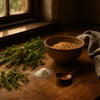Raspberry Sorbet Recipe That Bursts With Summer Flavor
Raspberry sorbet is the summer hero you didn't know you needed—bright, intensely flavorful, and refreshingly simple. This vibrant frozen treat captures the essence of fresh raspberries in a smooth, dairy-free dessert that's equally at home ending a backyard barbecue or cleansing the palate between courses at your next dinner party.
The perfect raspberry sorbet recipe balances sweet and tart notes while maintaining that gorgeous ruby-red color that makes everyone reach for seconds.
Key Takeaways
- Raspberry sorbet is a bright and intensely flavorful frozen treat perfect for summer.
- This dairy-free dessert captures the essence of fresh raspberries in a smooth texture.
- The sorbet balances sweet and tart flavors while showcasing a vibrant ruby-red color.
- It is versatile enough to serve at backyard barbecues or as a palate cleanser at dinner parties.
Table of Contents
- Summer's Sweet Indulgence: The Perfect Raspberry Sorbet
- Why Homemade Raspberry Sorbet Outshines Store-Bought Every Time
- Essential Ingredients for Perfect Raspberry Sorbet
- Equipment for Sorbet Success: From Simple to Sophisticated
- The Preparation Process: Transforming Berries into Brilliant Sorbet
- Freezing Techniques: The Path to Perfect Texture
- Serving and Presentation: Elevating Your Raspberry Sorbet
- Creative Variations: Making This Raspberry Sorbet Recipe Your Own
- Storage and Make-Ahead Tips: Keeping Your Sorbet Perfect
- Conclusion: Your Raspberry Sorbet Journey
Unlike ice cream with its heavy cream base, sorbet relies solely on fruit, sugar, and a touch of acid to create its magic—making it naturally vegan, dairy-free, and gloriously light. It's the dessert that doesn't weigh you down but still satisfies that sweet tooth with an explosion of authentic raspberry flavor.
At DI ORO, we believe that creating memorable food moments requires the right tools, and this sorbet is definitely a memory-maker. Let's dive into the world of this ruby-red delight and discover how to craft the perfect raspberry sorbet that bursts with summer in every spoonful.
Why Homemade Raspberry Sorbet Outshines Store-Bought Every Time

Let's be real—grocery store sorbets can be hit or miss. Some are packed with artificial flavors, others are icy rather than smooth, and many contain stabilizers and additives you can't pronounce. When you make raspberry sorbet at home, you're in control of every ingredient that touches your palate.
Homemade sorbet delivers an intensity of flavor that commercial versions simply can't match. Fresh raspberries bring a vibrancy that transforms a simple frozen dessert into something that makes people pause mid-bite and ask, "How did you make this?"
Plus, there's something deeply satisfying about watching a handful of simple ingredients transform into a luxurious dessert. It's culinary alchemy at its most approachable—no formal training required, just good ingredients and a bit of patience.
The Surprising Health Benefits of Your Raspberry Sorbet Obsession
While we're not claiming dessert as a health food, raspberry sorbet does have some nutritional bragging rights. Raspberries are packed with:
- Antioxidants that help fight inflammation
- Vitamin C for immune support
- Fiber that supports digestive health
- Lower sugar content than many other desserts (especially when you control the sweetness)
When you make sorbet at home, you're also skipping the artificial colors, flavors, and preservatives that often lurk in commercial frozen treats. It's a cleaner indulgence that lets the natural beauty of raspberries shine through.
Essential Ingredients for Perfect Raspberry Sorbet
The beauty of raspberry sorbet lies in its simplicity. You only need a handful of ingredients to create something truly spectacular:
Fresh vs. Frozen Raspberries: Which Creates the Better Sorbet?
Both fresh and frozen raspberries can produce excellent sorbet, but they bring different advantages to your freezer:
Fresh raspberries deliver unmatched brightness of flavor and that gorgeous ruby color that makes raspberry sorbet so irresistible. If you're making sorbet during raspberry season (typically summer), fresh berries straight from the farmer's market or your garden will give you the most vibrant result. Look for plump, fragrant berries with no signs of mold or mushiness.
Frozen raspberries are your year-round solution and often more economical. They're picked and frozen at peak ripeness, so they can actually deliver more consistent flavor than off-season fresh berries. The freezing process breaks down the cell walls, which can make them easier to purée. Just be sure to thaw them completely and drain any excess liquid before proceeding with your recipe.
The verdict? Both work beautifully—choose based on season, availability, and budget. Your sorbet will be delicious either way. For more tips on working with frozen raspberries and other fruits, check out our guide to liquid measuring cups for accuracy in your recipes.
Finding the Sweet Spot: Sugar Options for Your Sorbet
While granulated sugar is the traditional choice for sorbet, you have options:
- Granulated sugar: The classic choice that dissolves easily and produces reliable results
- Honey: Adds complexity and floral notes, but use about 25% less than sugar as it's sweeter
- Maple syrup: Brings warm, caramel-like undertones that complement raspberries beautifully
- Agave nectar: Has a lower glycemic index and a neutral flavor that lets the raspberries shine
Whichever sweetener you choose, remember that proper sweetness isn't just about taste—it's about texture. Sugar lowers the freezing point of your sorbet mixture, preventing it from freezing into a solid block of ice. Too little sugar and you'll end up with an icy, hard-to-scoop dessert; too much and it won't freeze properly. You can find more in-depth raspberry sorbet recipe science and troubleshooting at this authoritative raspberry sorbet guide.
The Acid Balancing Act: Why Your Sorbet Needs a Squeeze of Citrus
That tablespoon of lemon or lime juice isn't just an afterthought—it's essential chemistry. Acid brightens the fruit flavor and balances sweetness, transforming a one-note sweet treat into a complex, refreshing dessert that dances on your taste buds.
Lemon juice is the traditional choice, but lime juice can add an interesting twist, especially if you're planning to add herbs like basil or mint. A small amount goes a long way—start with a tablespoon and adjust to taste.
Equipment for Sorbet Success: From Simple to Sophisticated
Creating restaurant-quality raspberry sorbet at home doesn't require professional equipment, but having the right tools makes the process smoother (just like your sorbet).
The Essential Tools Every Sorbet Maker Needs
At minimum, you'll need:
- Fine-mesh strainer: Essential for removing those pesky raspberry seeds and achieving silky-smooth texture
- Food processor or blender: For creating the smoothest possible fruit purée
- Shallow freezer container: Allows for more even freezing, especially if you're not using an ice cream maker
- DI ORO Seamless Silicone Spatula: Perfect for scraping every last bit of precious raspberry purée from your blender and through your strainer without waste (America's Test Kitchen's top pick for a reason!)
With these basic tools, you can create delicious sorbet using the freeze-and-stir method. But if you're ready to level up your frozen dessert game, consider investing in an ice cream maker.
The Ice Cream Maker Advantage: Is It Worth It?
While not essential, an ice cream maker creates noticeably smoother sorbet with less effort. The continuous churning incorporates air and prevents large ice crystals from forming, resulting in a silkier texture that more closely resembles professional sorbet.
If you enjoy frozen desserts and make them frequently, an ice cream maker is worth considering. Models range from affordable freezer-bowl styles to self-refrigerating units, depending on your budget and counter space.
No ice cream maker? No problem. We'll cover both churned and no-churn methods in the preparation section, so you can create spectacular raspberry sorbet regardless of your equipment.
With our ingredients assembled and equipment ready, we're set to begin the transformation from humble raspberries to spectacular sorbet. In the next section, we'll walk through the preparation process step by step, from creating the perfect simple syrup to achieving that smooth, scoopable texture that makes homemade sorbet so satisfying.
The Preparation Process: Transforming Berries into Brilliant Sorbet

Ready to turn those vibrant raspberries into a frozen masterpiece? Let's break down the process into manageable steps that will have you creating sorbet like a pro. The magic happens when simple ingredients meet proper technique—and with DI ORO's kitchen tools by your side, you'll capture every last drop of that gorgeous raspberry flavor.
The Simple Syrup Foundation: Getting the Ratio Right
Simple syrup forms the sweet backbone of any good sorbet, and getting it right is crucial for both flavor and texture. Here's how to nail it:
In a small saucepan, combine 1 cup of water with 1 cup of granulated sugar (adjust to 3/4 cup for tarter sorbet or up to 1 1/2 cups for very sweet berries). Using our DI ORO Heat-Resistant Silicone Spatula—tested to withstand temperatures up to 600°F without melting or leaching chemicals—stir the mixture over medium heat until the sugar completely dissolves.
The key here? Patience. You want the sugar to dissolve fully without boiling the syrup for too long, which can create a thicker consistency than desired. Once dissolved, remove from heat and let cool completely to room temperature. This cooling step is non-negotiable—adding hot syrup to your raspberry purée can dull that vibrant color we're aiming for.
Raspberry Preparation: Maximizing Flavor While Minimizing Seeds
While your syrup cools, let's tackle those raspberries:
- If using fresh berries, rinse them gently under cool water and pat dry. If using frozen, thaw completely in a colander to drain excess liquid.
- Transfer 4-5 cups of raspberries to your food processor or high-powered blender.
- Pulse several times, then blend continuously until completely smooth—about 30-60 seconds.
- Here comes the game-changer: strain the purée through a fine-mesh sieve to remove those pesky seeds. This step requires a bit of patience, but your DI ORO Seamless Silicone Spatula is the perfect tool for the job—its flexible edge can press every bit of precious purée through the mesh while leaving the seeds behind.
Don't rush this straining step—it's what separates amateur sorbet from the silky-smooth professional version. Take your time to extract as much seedless purée as possible. Your patience will be rewarded with every velvety spoonful.
The Perfect Blend: Combining Your Ingredients for Optimal Flavor
Now for the moment when everything comes together:
- In a large bowl, combine your strained raspberry purée (you should have about 2 cups) with the cooled simple syrup.
- Add 1-2 tablespoons of fresh lemon juice—this brightens the flavor and helps maintain that gorgeous color.
- Optional but recommended: add 1 teaspoon of vanilla extract for depth and complexity.
- Whisk everything together until completely incorporated.
Now comes the crucial taste test. Dip your clean DI ORO Seamless Silicone Spatula into the mixture and give it a try. Remember that flavors become more muted when frozen, so your mixture should taste slightly sweeter and more intense than you want the final product to be. Need more sweetness? Add a tablespoon of sugar at a time. More tang? Another squeeze of lemon. This is your creation—make it perfect for your palate. For even more flavor options, see our red pepper coulis recipe for creative savory-sweet accompaniments.
Freezing Techniques: The Path to Perfect Texture
The freezing process is where good sorbet becomes great sorbet. Let's explore both methods so you can choose what works best for your kitchen setup.
The Ice Cream Maker Method: Smooth Sailing to Sorbet
If you're lucky enough to have an ice cream maker, your path to perfect sorbet is straightforward:
- Make sure your ice cream maker bowl has been properly frozen according to manufacturer instructions (usually 24 hours in advance).
- Pour your raspberry mixture into the frozen bowl of your ice cream maker.
- Churn according to manufacturer's instructions, typically 20-30 minutes.
- The sorbet is ready when it reaches a soft-serve consistency—it will firm up more in the freezer.
- Transfer to an airtight container and freeze for at least 2 hours before serving for scoopable perfection.
The continuous churning incorporates air and prevents large ice crystals from forming, resulting in that professional-quality smooth texture we're aiming for. America's Test Kitchen, which also recognized our DI ORO Seamless Spatula as their top pick, recommends this method for the smoothest possible results. For more information on achieving the best texture, visit the Buttermilk by Sam raspberry sorbet recipe for expert freezing tips.
No Ice Cream Maker? No Problem: The Freeze-and-Stir Method
Don't let the lack of specialized equipment stop you from sorbet greatness. The freeze-and-stir method requires a bit more attention but can still produce excellent results:
- Pour your raspberry mixture into a wide, shallow freezer-safe container. The wider and shallower, the better—this increases surface area and helps the mixture freeze more evenly.
- Place in the freezer, uncovered, for 45 minutes.
- Remove and stir vigorously with a fork or whisk, breaking up any ice crystals that have formed around the edges. Your DI ORO Seamless Silicone Spatula is perfect for scraping down the sides and incorporating the frozen portions.
- Return to the freezer and repeat this process every 30 minutes for about 3 hours, or until the sorbet reaches a scoopable consistency.
- Once it's nearly set, cover with an airtight lid or plastic wrap pressed directly onto the surface to prevent ice crystals.
The key to this method is consistency—don't skip the stirring intervals, as they're crucial for breaking up ice crystals and creating a smoother texture. Set a timer if needed to remind yourself when it's time for the next stir.
Texture Troubleshooting: Solving Common Sorbet Problems
Even experienced sorbet makers occasionally encounter texture issues. Here's how to troubleshoot:
Too icy or hard? Your sorbet might not have enough sugar or you might need to add a tablespoon of vodka or fruit liqueur—the alcohol lowers the freezing point and helps maintain a softer texture. Next time, increase your simple syrup slightly.
Too soft or not freezing properly? You may have added too much sugar or alcohol. Try adding more fruit purée to balance it out, or if it's just slightly too soft, simply freeze it longer.
Grainy texture? This usually happens when ice crystals form during freezing. For your next batch, make sure to churn more frequently if using the no-machine method, or consider adding a tablespoon of corn syrup to the mixture, which helps prevent crystallization.
Serving and Presentation: Elevating Your Raspberry Sorbet
You've created a gorgeous ruby-red dessert—now let's make sure it looks as amazing as it tastes when you serve it.
The Perfect Scoop: Timing and Technique
Sorbet has a narrower perfect-texture window than ice cream. Too cold and it's rock hard; too warm and it melts into raspberry soup. For the ideal serving consistency:
- Remove your sorbet from the freezer about 5-10 minutes before serving, depending on the temperature of your freezer and the room.
- Use a scoop dipped in warm water between each serving for clean, beautiful scoops that release easily.
- If your sorbet is too firm, patience is better than microwaving! Let it sit at room temperature until scoopable.
For an extra touch of elegance, chill your serving dishes in the freezer for about 15 minutes before scooping. This prevents premature melting and gives you more time to enjoy that perfect texture.
Garnish Ideas That Take Your Sorbet from Good to Gorgeous
A thoughtful garnish not only adds visual appeal but can complement and enhance the raspberry flavor:
- Fresh whole raspberries or a mix of fresh berries
- A sprig of fresh mint or basil
- A light dusting of finely grated white chocolate
- A delicate cookie like a thin shortbread or langue de chat
- A drizzle of dark chocolate sauce for a raspberry-chocolate combination
- A splash of prosecco poured over the sorbet for an instant grown-up dessert
Remember that the vibrant color of raspberry sorbet is already a visual statement—sometimes simple is best. A single perfect raspberry and a sprig of mint can be all you need to create an Instagram-worthy dessert. If you love creative garnishes, explore our zesters and graters collection to add the perfect citrus zest to your presentation.
Perfect Pairings: What to Serve With Your Raspberry Sorbet
Raspberry sorbet works beautifully as a standalone dessert, but it also plays well with others:
- Serve alongside a slice of dark chocolate cake for a sophisticated contrast
- Pair with shortbread cookies for textural contrast
- Use as a palate cleanser between courses at a dinner party
- Float a small scoop in a glass of champagne for an elegant dessert cocktail
- Sandwich between two thin almond cookies for a quick dessert
For a truly special presentation, try serving your sorbet in frozen lemon or orange halves, or even in hollowed-out chocolate cups—the combination of flavors and the unexpected presentation will delight your guests. For more dessert inspiration, see our coconut sorbet recipe for another dairy-free frozen favorite.
In the final section of our guide, we'll explore creative variations on this classic raspberry sorbet recipe, storage tips to keep your creation at its best, and answer some frequently asked questions to ensure sorbet success every time.
Creative Variations: Making This Raspberry Sorbet Recipe Your Own

The beauty of mastering a classic raspberry sorbet recipe is that it becomes a springboard for culinary creativity. Once you've nailed the basic technique, it's time to play with flavors and make this recipe uniquely yours. Here are some inspired variations that will keep your dessert game fresh and exciting:
Flavor Infusions: Taking Your Sorbet to the Next Level
Elevate your raspberry sorbet with these flavor-boosting additions:
- Herb-infused: Add 1/4 cup of fresh basil, mint, or lemon verbena leaves to your simple syrup while it's still hot. Let steep for 30 minutes, then strain before combining with raspberry purée.
- Spice-infused: Add a cinnamon stick, star anise, or 3-4 cardamom pods to your hot simple syrup. The warmth of these spices creates an unexpected but delightful contrast with the bright raspberry flavor.
- Citrus zest: Add the zest of one lemon, lime, or orange to your mixture for a subtle aromatic note that amplifies the raspberry's natural brightness.
- Rose water: Add 1-2 teaspoons of rose water for a sophisticated, floral note that pairs beautifully with raspberries.
When experimenting with infusions, remember that less is more—you want to complement the raspberry flavor, not compete with it. Start with small amounts and adjust to taste. Your DI ORO Silicone Spatula will help you fold these delicate flavors in without crushing those precious air bubbles that keep your sorbet light and smooth.
Berry Blends: Raspberry's Perfect Partners
While pure raspberry sorbet is a classic, berry blends can create complex and exciting flavor profiles:
- Raspberry-Blackberry: Replace 1/3 of the raspberries with blackberries for a deeper, more intense berry flavor.
- Raspberry-Strawberry: Combine equal parts raspberries and strawberries for a sweeter, more approachable sorbet that kids especially love.
- Triple Berry Blend: Equal parts raspberries, blackberries, and blueberries create a sophisticated, antioxidant-rich treat with gorgeous color.
When creating berry blends, you may need to adjust your sugar levels slightly depending on the natural sweetness of the additional berries. America's Test Kitchen, which recognized our DI ORO Seamless Spatula as their top pick, recommends tasting and adjusting sweetness before freezing for optimal results. For more ideas on berry desserts, visit this professional raspberry sorbet recipe.
Adult Variations: Spirited Sorbets
For an adults-only treat, consider these boozy variations:
- Raspberry Champagne Sorbet: Replace 1/4 cup of the water in your simple syrup with champagne or prosecco.
- Raspberry Limoncello: Add 2 tablespoons of limoncello liqueur to your base mixture.
- Raspberry Rosé: Substitute 1/4 cup of the water with a dry rosé wine for a sophisticated summer dessert.
Remember that alcohol lowers the freezing point, so boozy sorbets will be softer and melt more quickly. You may need to freeze them longer or reduce the amount of simple syrup slightly to compensate.
Storage and Make-Ahead Tips: Keeping Your Sorbet Perfect
You've created sorbet perfection—now let's make sure it stays that way with proper storage techniques that preserve both flavor and texture.
Proper Storage: Maintaining Optimal Texture
Homemade sorbet doesn't contain the stabilizers found in commercial versions, so proper storage is crucial:
- Store in a shallow, airtight container to minimize exposure to air.
- Place a piece of parchment paper or plastic wrap directly on the surface of the sorbet before putting the lid on to prevent ice crystals.
- Keep your sorbet in the coldest part of your freezer, away from the door where temperature fluctuations occur.
- For best texture, consume within 1-2 weeks—though the flavor will remain good for up to a month.
If you notice ice crystals forming over time, you can re-blend the sorbet in a food processor and refreeze for a smoother texture. Your DI ORO Silicone Spatula will help you transfer every last bit without wasting any of your delicious creation. For more tips on caring for your kitchen gear, see our stainless steel kitchen utensils care guide.
Make-Ahead Strategies for Entertaining
When entertaining, the last thing you want is last-minute dessert stress. Here's how to plan ahead:
- Prepare your raspberry base mixture up to 3 days in advance and store in the refrigerator.
- Churn the sorbet the day before your event for optimal texture.
- For individual servings, pre-scoop your sorbet onto a parchment-lined baking sheet and freeze until solid, then transfer the scoops to a container. This allows for quick plating when guests arrive.
- Create a sorbet bar by preparing several variations and letting guests choose their own toppings and garnishes.
For the ultimate make-ahead dessert, prepare raspberry sorbet sandwiches by placing a scoop between two thin cookies, then wrapping individually and freezing. These can be made up to a week in advance and served straight from the freezer. If you want to discover more kitchen essentials for storing and serving, browse our full collection of DI ORO kitchen tools.
Frequently Asked Questions: Troubleshooting Your Sorbet
Q: Why is my sorbet too icy?
A: This usually happens when there's not enough sugar or when the mixture wasn't churned enough. The sugar in sorbet doesn't just provide sweetness—it's crucial for texture. Try adding a bit more simple syrup next time or churning more frequently if using the no-machine method.
Q: Can I use frozen raspberries?
A: Absolutely! Frozen raspberries often have more consistent flavor than out-of-season fresh ones. Just thaw them completely and drain any excess liquid before pureeing.
Q: Is it necessary to strain out the seeds?
A: While not strictly necessary, straining creates that professional, silky-smooth texture that elevates homemade sorbet. If you don't mind the seeds, you can skip this step, but the texture difference is noticeable.
Q: Can I make this recipe without sugar?
A: Sugar is important not just for sweetness but for texture. However, you can experiment with alternatives like honey (use 3/4 cup honey to replace 1 cup sugar) or agave nectar. Keep in mind that each sweetener will slightly alter the flavor profile and freezing properties.
Q: Why did my sorbet never freeze properly?
A: This could be due to too much sugar or alcohol, or your freezer temperature might be too high. Try reducing the sweetener slightly or checking your freezer settings.
Conclusion: Your Raspberry Sorbet Journey
From selecting the perfect raspberries to mastering the freeze, you've now got all the knowledge you need to create a raspberry sorbet that rivals any gourmet dessert shop. The beauty of homemade sorbet lies not just in its fresh, vibrant flavor, but in knowing exactly what goes into it—no artificial colors, no mysterious additives, just pure raspberry goodness.
Just like DI ORO's forever-chemical-free kitchen tools protect what touches your food, this homemade sorbet recipe puts you in control of what goes into your dessert. Whether you're creating a palate cleanser for a dinner party, a refreshing summer treat, or just satisfying a craving for something both indulgent and light, this raspberry sorbet delivers on all fronts.
So grab your DI ORO Seamless Silicone Spatula (the one America's Test Kitchen named their top pick), some fresh or frozen raspberries, and let your culinary creativity shine. Because when you have the right tools and techniques, even something as seemingly fancy as sorbet becomes an accessible, joyful part of your cooking repertoire.
Now, the only question that remains is: which variation will you try first?
Frequently Asked Questions
How to make the best raspberry sorbet?
To make the best raspberry sorbet, start with ripe, fresh raspberries for that vibrant flavor. Blend the berries with a simple syrup made from sugar and water to balance tartness, then churn the mixture in an ice cream maker until smooth and frozen. For an extra silky texture, strain the sorbet to remove seeds before freezing, and serve chilled for a refreshing treat.
How does sorbet get creamy?
Sorbet gets creamy through the balance of sugar, water, and air incorporated during churning, which prevents large ice crystals from forming. The sugar lowers the freezing point, keeping the sorbet soft, while churning adds tiny air bubbles that give it a smooth, scoopable texture. Using pureed fruit with natural pectin can also enhance creaminess.
Is raspberry sorbet the same as raspberry sherbet?
No, raspberry sorbet and raspberry sherbet are not the same. Sorbet is dairy-free, made primarily of fruit puree, sugar, and water, while sherbet includes a small amount of dairy like milk or cream, making it richer and creamier. Sorbet offers a pure fruit flavor with a lighter texture, whereas sherbet has a creamier mouthfeel.
Is sorbet healthier than ice cream?
Generally, sorbet is healthier than ice cream because it contains no dairy and usually less fat, making it a lighter option. It’s mostly fruit and sugar, so it’s lower in calories and cholesterol but can still be sweet. However, portion control and sugar content matter, so enjoy sorbet as a refreshing treat that’s often a better fit for those avoiding dairy or fat.
How do you keep sorbet creamy?
To keep sorbet creamy, ensure you use the right balance of sugar to inhibit large ice crystals and churn the mixture thoroughly to incorporate air. Storing sorbet in an airtight container helps prevent freezer burn and ice buildup. Adding a splash of lemon juice or alcohol can also improve texture by lowering the freezing point, keeping your sorbet smooth and scoopable.
What thickens sorbet?
Sorbet thickens naturally thanks to the sugar content and the fruit’s natural pectin, which helps create a smooth texture. Some recipes use stabilizers like corn syrup or a small amount of gelatin to improve thickness and prevent icy crystals. Proper churning and freezing techniques also play a crucial role in achieving that perfect sorbet consistency.




